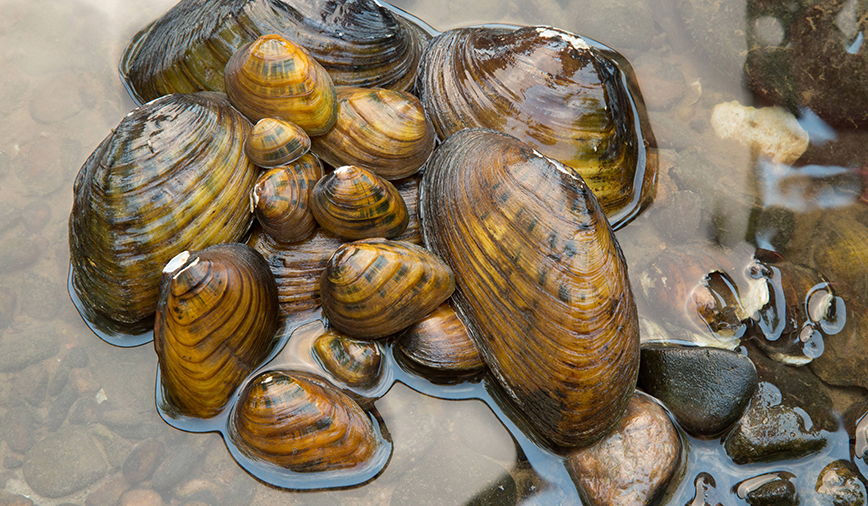It’s April, and the spring migration is in full swing. Flashy neotropical migrants like scarlet tanagers have begun their epic journeys from South America and should be spotted here within a month. Meanwhile, the magnificent white pelicans have arrived at Dick Young Forest Preserve in Batavia on their annual stopover from points south. And then we have the freshwater mussels, whose seasonal movements can be measured in…centimeters.
Okay, so maybe freshwater mussels aren’t the most charismatic of creatures. Their shells are not very colorful, they don’t make any noise, and they live at the bottom of our local rivers and streams. Not exactly the sorts of qualities that will earn them movie deals or even a spot as a school mascot.
And that’s too bad. Because despite their quiet existence, freshwater mussels are some of our most fascinating wild neighbors.
Their very existence is a wonder. Think about it. Here’s an animal that’s stripped down to a few bare essentials; no arms or legs, no fancy feathers or fur, just a shell and an assortment of vital organs. Yet still it manages to reproduce and disperse its young. How can this be?
The answer, my friend, is blowin’ in the…water. Male mussels fertilize females by releasing sperm into the water; females take in the sperm and the eggs begin to develop. Space is limited inside those shells, though, so it’s not long before mama mussel expels her young family back into the current.
With luck the young, called glochidia, attach themselves to a host animal—usually a fish—and spend the next several weeks growing and, hopefully, traveling far from whence they came. When the time is right, they break free of the gill or fin they’ve called home and drop down onto the stream bed. Their hitchhiking days over, the mussels now begin an independent life, one that may last anywhere from a decade to more than a century.
As if their life cycle isn’t reason enough to admire our mussels, take a minute to check out their names. Many are wonderful descriptors that reflect the culture of times gone by. Can’t you just picture the unfortunate incident that led to the naming of the white heelsplitter? Or the comparison that resulted in the name plain pocketbook? Walk our local creeks and you may also find pigtoes, elktoes and pimplebacks. Travel a bit further afield and you’ll likely run into the pistolgrip, washboard and—my personal favorite—the monkeyface.
In another brush with human culture, freshwater mussels provided the basis for a thriving, though short-lived, industry. Around the turn of the 20th century, a German entrepreneur named Johann Böpple invented a machine that could make buttons from mussel shells. In the ensuing few decades, thousands of tons of freshwater mussels were harvested, cleaned and drilled to make “pearl” buttons.
Here along the Fox River, the boom came quickly and left just as fast. In just a few years, our local mussel beds were depleted. Although clammers at the time blamed pollution for the precipitous drop in mussel numbers, overharvesting really was to blame.
Today, mussels in the Fox River have staged a bit of a comeback, but life on the river bottom isn’t easy. Silt is a constant threat, clogging mussels’ delicate organs and sometimes burying the little guys outright. Mussels also must contend with competition from exotic species like Asian clams, as well as the pesticides and fertilizers that run off our lawns, into storm sewers and directly into the river. What’s a poor mussel to do?
If you’d like to learn the answer to this and other mussel musings, join us at 7 p.m. this Thursday at the Pottawatomie Community Center in St. Charles for a discussion of “Illinois’ Freshwater Mussels.” Fee is $10. Refer to bar code 3978. For registration information, please call the St. Charles Park District at 630-513-6200.
Pam Otto works for the St. Charles Park District and can be reached at potto@stcparks.org or 630-513-4346.

